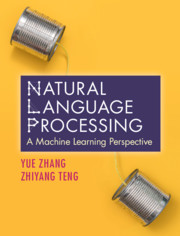Refine search
Actions for selected content:
3312 results in Artificial Intelligence and Natural Language Processing
Acknowledgements
-
- Book:
- Natural Language Processing
- Published online:
- 16 December 2020
- Print publication:
- 07 January 2021, pp xv-xv
-
- Chapter
- Export citation
Part III - Deep Learning
-
- Book:
- Natural Language Processing
- Published online:
- 16 December 2020
- Print publication:
- 07 January 2021, pp 287-288
-
- Chapter
- Export citation
17 - Pre-training and Transfer Learning
- from Part III - Deep Learning
-
- Book:
- Natural Language Processing
- Published online:
- 16 December 2020
- Print publication:
- 07 January 2021, pp 396-422
-
- Chapter
- Export citation
14 - Representation Learning
- from Part III - Deep Learning
-
- Book:
- Natural Language Processing
- Published online:
- 16 December 2020
- Print publication:
- 07 January 2021, pp 314-342
-
- Chapter
- Export citation
11 - Transition-Based Methods for Structured Prediction
- from Part II - Structures
-
- Book:
- Natural Language Processing
- Published online:
- 16 December 2020
- Print publication:
- 07 January 2021, pp 235-258
-
- Chapter
- Export citation
Contents
-
- Book:
- Natural Language Processing
- Published online:
- 16 December 2020
- Print publication:
- 07 January 2021, pp v-x
-
- Chapter
- Export citation
7 - Generative Sequence Labelling
- from Part II - Structures
-
- Book:
- Natural Language Processing
- Published online:
- 16 December 2020
- Print publication:
- 07 January 2021, pp 147-168
-
- Chapter
- Export citation
4 - Discriminative Linear Classifiers
- from Part I - Basics
-
- Book:
- Natural Language Processing
- Published online:
- 16 December 2020
- Print publication:
- 07 January 2021, pp 73-97
-
- Chapter
- Export citation
8 - Discriminative Sequence Labelling
- from Part II - Structures
-
- Book:
- Natural Language Processing
- Published online:
- 16 December 2020
- Print publication:
- 07 January 2021, pp 169-189
-
- Chapter
- Export citation
12 - Bayesian Network
- from Part II - Structures
-
- Book:
- Natural Language Processing
- Published online:
- 16 December 2020
- Print publication:
- 07 January 2021, pp 259-286
-
- Chapter
- Export citation
3 - Feature Vectors
- from Part I - Basics
-
- Book:
- Natural Language Processing
- Published online:
- 16 December 2020
- Print publication:
- 07 January 2021, pp 50-72
-
- Chapter
- Export citation
Preface
-
- Book:
- Natural Language Processing
- Published online:
- 16 December 2020
- Print publication:
- 07 January 2021, pp xi-xiv
-
- Chapter
- Export citation
15 - Neural Structured Prediction
- from Part III - Deep Learning
-
- Book:
- Natural Language Processing
- Published online:
- 16 December 2020
- Print publication:
- 07 January 2021, pp 343-369
-
- Chapter
- Export citation
5 - A Perspective from Information Theory
- from Part I - Basics
-
- Book:
- Natural Language Processing
- Published online:
- 16 December 2020
- Print publication:
- 07 January 2021, pp 98-119
-
- Chapter
- Export citation
Bibliography
-
- Book:
- Natural Language Processing
- Published online:
- 16 December 2020
- Print publication:
- 07 January 2021, pp 453-467
-
- Chapter
- Export citation
18 - Deep Latent Variable Models
- from Part III - Deep Learning
-
- Book:
- Natural Language Processing
- Published online:
- 16 December 2020
- Print publication:
- 07 January 2021, pp 423-452
-
- Chapter
- Export citation
Part I - Basics
-
- Book:
- Natural Language Processing
- Published online:
- 16 December 2020
- Print publication:
- 07 January 2021, pp 1-2
-
- Chapter
- Export citation
Recent advances in processing negation
-
- Journal:
- Natural Language Engineering / Volume 27 / Issue 2 / March 2021
- Published online by Cambridge University Press:
- 17 December 2020, pp. 121-130
-
- Article
-
- You have access
- Open access
- HTML
- Export citation

Natural Language Processing
- A Machine Learning Perspective
-
- Published online:
- 16 December 2020
- Print publication:
- 07 January 2021
-
- Textbook
- Export citation
NLE volume 27 issue 1 Cover and Front matter
-
- Journal:
- Natural Language Engineering / Volume 27 / Issue 1 / January 2021
- Published online by Cambridge University Press:
- 15 December 2020, pp. f1-f2
-
- Article
-
- You have access
- Export citation
